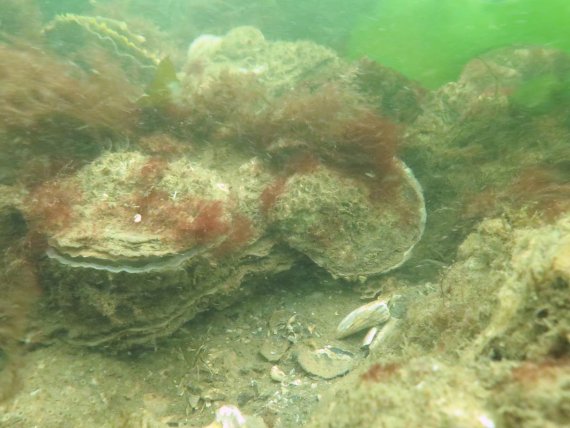<Oysters in the Voordelta; photo: Wouter Lengkeek, Bureau Waardenburg>
Divers of Bureau Waardenburg found the reef while looking for suitable places to lay out new shellfish banks. Together with Wageningen Marine Research and Sas Consultancy, this agency studies the recovery of nature off the Zeeland coast. This study was commissioned by the World Wide Fund for Nature and the Ark foundation.
Oyster banks
There used to be a lot of flat oysters in the North Sea, tells shellfish researcher Aad Smaal. Around 1880, there were vast oyster banks, known as the Centrale Oestergronden (‘Central Oyster Grounds’). However, these oyster banks disappeared due to overfishing and bottom-stirring fishing practices. Now that parts of the North Sea have been closed for trawling and three large wind farms are being built off the Dutch coast, Marine Research studies how and where oyster banks will be able to develop once more.
The reef is located in shallow and agitated waters, which in our opinion is not an ideal place for oysters
The discovery of the oyster reef off the coast of Zeeland happened by chance during another project at the estuary of the Haringvliet. Divers were searching the sea for suitable places to lay out the oysters, when they discovered that nature had been ahead of them. Just outside the Brouwersdam was an oyster bank 13 hectares in size. Smaal: ‘That was a real surprise. The reef is located in shallow and agitated waters, which in our opinion is not an ideal place for oysters. This is a huge incentive for the recovery of oysters in the North Sea. We can now perform focused research on the conditions required for the recovery of nature and how oyster banks develop.’
This is a huge incentive for the recovery of oysters in the North Sea
Smaal suspects that the larvae of this oyster bank originate from the Grevelingenmeer, where oysters are cultivated on a large scale. However, it seems that by now the newly discovered reef produces enough larvae to sustain itself.
Living community
An oyster bank is actually a living community. It does not merely contain flat oysters, the oysters that originally occurred in the Netherlands, but also Pacific oysters, mussels, anemones, sponges, worms and crustaceans. Such a reef is a hotspot of biodiversity, says Smaal. But success is not assured for the oysters, as starfish could completely ravage a young oyster bank, says Smaal.
For years, the flat oyster was a problem child because she was decimated by a parasite and was overrun by the Pacific oyster – a larger, imported relative. But the native oyster has been on the rise again in recent years. If the recovery continues and the reintroduction of oyster banks in the North Sea is successful, Smaal sees a possibility for new livelihood for Dutch oyster farmers. ‘If the oyster banks grow to more serious sizes, they will need maintenance, for example by helping combat starfish. This could be combined with an extensive oyster harvest. This would become a form of agricultural nature conservation in the sea.’

